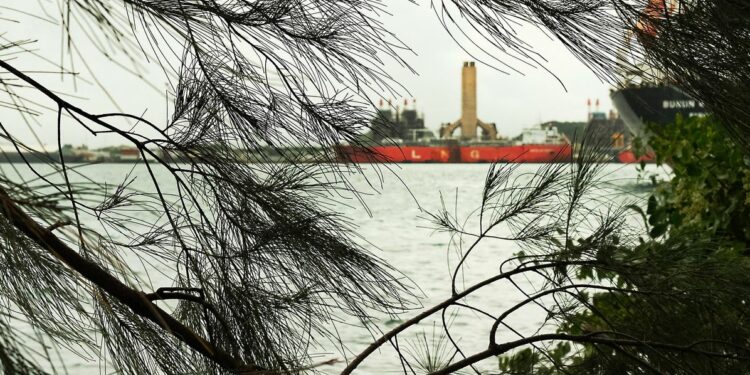New Fortress Energy’s controversial LNG import facility is seen through trees in the nearby neighborhood of Cataño, Puerto Rico. Alexander Kaufman/HuffPost
This story is part of a three-part series on Puerto Rico’s energy transition. Part two will be pushed on Sunday, and part three will appear on Monday.
CATAÑO, Puerto Rico — Just before the rain began one afternoon in July, Lissette Avilés Ríos went looking for the best spot along the shoreline to see the ship she feared might bring fiery death.
The nun hopped in her SUV and drove from her convent in this coastal neighborhood on the opposite side of San Juan Bay from scenic Viejo San Juan, past dockyards and down streets where gray pipelines stacked as high as the rooftops hemmed in some houses on two sides. Pulling into a vacant lot on the water, she got out, approached the edge and pulled back the feathery needles of a white pine just barely clinging to the eroding shore.
The letters etched along the red-painted hull of the tanker ship spelled out the cargo: LNG, for liquefied natural gas.
The Coral Encanto arrived in San Juan Bay late one night in January 2023 — months before the United States emerged as the world’s top exporter of methane gas superchilled into a dense liquid form for easier transportation and sold overseas as a fuel that’s generally cleaner-burning than coal or petroleum and more dependable than solar panels and wind turbines.
The ship never left. The semipermanently moored vessel serves as the floating storage unit for a terminal that the energy company now in charge of Puerto Rico’s power plants uses to import LNG. On a summer afternoon, another tanker, the Avenir Accolade, sidled up beside the Coral Encanto, unloading a fresh shipment of the fuel.
To Avilés, it’s a ticking time bomb.
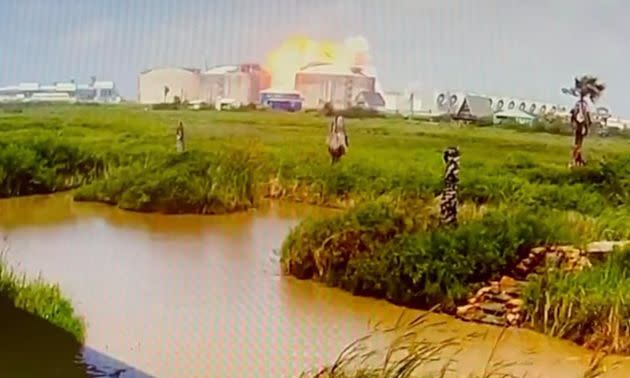
An explosion at Freeport LNG’s export plant in Texas, June 2022. Courtesy Quintana Beach County Park/Facebook
In June 2022, one of the nation’s largest LNG export terminals on the Texas Gulf Coast exploded, sending an orange ball of fire into the sky with a vapor-cloud blast so powerful, two lifeguards at nearby Quintana Beach were blown off their chairs and a toddler fell and bloodied his face on a rock. Federal pipeline safety regulators later released a heavily redacted consultant’s report that blamed inadequate testing and procedures, identifying what experts saw as a growing risk at a time when the U.S. economy was becoming increasingly reliant on burning, liquefying, shipping and selling natural gas.
“There are very serious and unique risks for LNG above and beyond other forms of transporting hydrocarbons due to its high pressure and density,” said Hailey Duncan, a policy adviser at the watchdog group Pipeline Safety Trust. “These risks are especially concerning when a facility is placed near people.”
The Texas LNG terminal’s emergency plan was not “adequate,” environmentalists and community activists complained after the accident.
At least the facility had a federally approved emergency plan.
Here in Puerto Rico, a politically connected natural gas company from New York turned a tanker into a makeshift LNG port in the center of a hurricane-prone metropolis — and, perhaps counterintuitively, insisted to regulators that the improvised import terminal actually meant the whole operation should be free to skip the usual federal safety steps.
New Fortress Energy built its LNG terminal without the required federal permits. Federal regulators later ordered the company to retroactively go through the permitting process, but exempted the project from holding public hearings and allowed the facility to continue operating in the meantime without an approved emergency response plan.
Despite eased requirements, New Fortress has yet to submit a finalized emergency plan and has repeatedly warned investors it may not be able to secure approval from the Federal Energy Regulatory Commission. Last month, the company said its heavily redacted draft proposal was still under review by local emergency authorities. An updated version is due by the end of November.
In the meantime, however, New Fortress is looking to bring in bigger vessels with even larger shipments of gas, despite a warning in September from the U.S. Coast Guard that the company is bringing in boats too large for San Juan Bay.
New Fortress did not respond to multiple requests for comment.
The saga highlights Puerto Rico’s haphazard transition away from petroleum, and illustrates the degree to which voters have been cut out of decisions that lock an already impoverished and deeply indebted island into an energy system that depends on regular imports of a globally traded, planet-heating fuel that’s prone to price shocks.
“It really seems like Puerto Rico is being exploited by New Fortress,” said Cathy Kunkel, an energy researcher based in San Juan who works for the watchdog Institute for Energy Economics and Financial Analysis. “This is very transparently a push for more natural gas.”
‘Regulatory Gaps’ Haunt All Sides
Puerto Rico’s sprawling capital, where the vast majority of the territory’s 3.3 million people live, is no stranger to the threat that loosely regulated fossil fuel facilities pose.
On October 23, 2009, an explosion ripped through the Caribbean Petroleum Corporation refinery in Bayamón, the metro-area jurisdiction that borders Cataño to the south. While offloading gasoline from a tanker ship, one of the facility’s 5 million-gallon aboveground tankers overflowed, aerosolized and formed a vapor cloud that drifted to a wastewater treatment area and ignited. The blast damaged nearly 300 homes and forced the government to evacuate 3,000 people from a nearby prison and other state facilities. The resulting fire lasted about three days, exposing tens of thousands of people to fallout from a smoke plume that extended miles out to sea. About 30 million gallons of petroleum were released via stormwater channels into the wetlands surrounding San Juan Bay, killing fish and birds, including endangered species.
Federal investigators later concluded that regulators had failed to require inspectors “to conduct a thorough evaluation of an emergency response plan that encompasses catastrophic failure of multiple tanks at once.”
Roughly a decade later, New Fortress was completing work on its LNG terminal just about a 10-minute drive up Highway 5 — without any federally approved emergency response plan at all.
The company was born of the great American fracking bonanza of the 2010s, when U.S. drillers — fueled by cheap money from Wall Street — mastered the hydraulic fracturing technique and transformed a nation once accused of invading Iraq to secure fuel supplies into a top global producer of oil and gas, surpassing Saudi Arabia, Qatar and Russia.
New Fortress, founded in 2014, arrived during the boom times.
The U.S. had begun transitioning away from coal and nuclear power to gas. Even in climate-conscious states with ambitious goals to generate most of the power supply from wind turbines and solar panels, gas-fired stations proliferated as backup for when the air was still and the sky was dark.
Gas operated differently than coal or nuclear. While coal could be stored in giant piles on site and nuclear reactors only required fresh uranium fuel every few years, gas plants depended on vast interstate networks of pipelines being constantly replenished with new supply. Few gas plants store large volumes of natural gas on site.
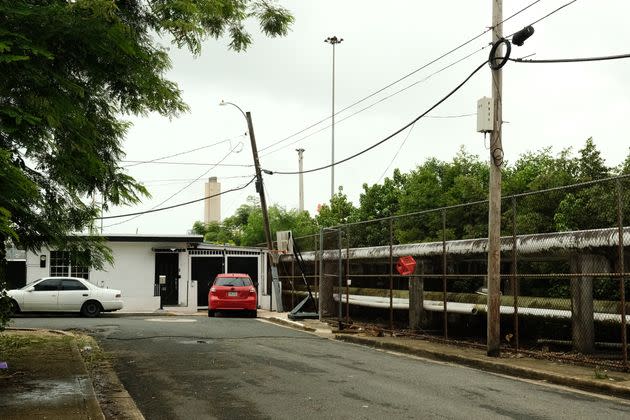
Pipelines run alongside residential homes in Cataño, Puerto Rico, a low-income neighborhood in the San Juan metropolitan area. Alexander Kaufman/HuffPost
Puerto Rico had no connections to pipeline networks or neighboring grid systems. That left the Puerto Rico Electric Power Authority, the state-run utility that served the territory, reliant on petroleum-based fuels like diesel, which are easier to store. Those fuels are also more expensive. Like the rest of the Puerto Rican government, PREPA issued bonds to borrow money from investors. The debt piled up into the billions. In 2016, Puerto Rico went bankrupt.
Not an independent country, the island could not seek a bailout from international lenders. Not a fully integrated part of the U.S., either, the territory could not access the legal protections afforded to American states and municipalities. Instead, Congress passed the PROMESA Act — named after the Spanish word for “promise” — which installed a board of financial overseers appointed by the White House with final say over how the territory’s elected government would spend money.
The diesel-based system was costly to run. But LNG came with its own high price tag and big risks, according to a March 2017 study commissioned by PREPA. Even with natural gas prices falling, “the capital cost for natural gas transportation infrastructure remains high,” the report found, warning that gas projects “benefit from economies of scale, suggesting the potential for greater returns from larger markets than from smaller ones.”
“The costs and operational risks for LNG delivery” to San Juan, the study concluded, were “prohibitively high.”
To New Fortress, however, Puerto Rico was a prime opportunity. The company had already established multiple facilities in Jamaica as part of a rapid expansion across the Caribbean and Latin America. Legally speaking, the territory was on home turf.
Attorneys working for New Fortress and firms owned by its parent company came from the same law firms used by Puerto Rico’s then-governor and Financial Oversight and Management Board, the federally appointed panel the PROMESA Act had given veto power over the island’s spending.
Once Hurricane María made landfall in 2017 and laid waste to the aging grid system, New Fortress offered a novel legal argument for how it could quickly set up a gas terminal in San Juan to get the lights back on ― and secure itself a slice of the billions of dollars Congress would go on to allocate for Puerto Rico’s reconstruction.
Unlike most other U.S. gas import terminals subject to Federal Energy Regulatory Commission permitting, this project in San Juan Bay would not connect to any interstate pipeline networks. As a result, the company argued in legal filings, the LNG terminal wasn’t regulated under the Natural Gas Act of 1938, the bedrock federal law setting rules for transporting the fuel.
Instead, its facility works like this: When an LNG tanker delivers a fresh shipment, it pumps the gas directly into the Coral Encanto, which serves as the floating storage unit. From there, the gas is either distributed directly to the San Juan Power Plant next to the terminal, where it’s converted from its traveling state back into its usable form and then burned to produce electricity, or into trucks to be delivered elsewhere on the island.
The pitch worked with the local government. In March 2019, PREPA awarded New Fortress a $1.5 billion contract to convert two units at the San Juan power station to run on gas as well as fuel oil, to supply the new units with fuel. At a press conference, then-Gov. Ricardo Rosselló said the project would be online within a year.
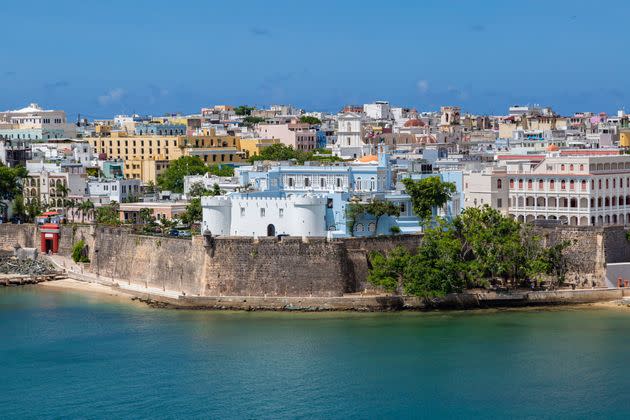
La Fortaleza in Old San Juan serves as the residence of the governor of Puerto Rico. UCG via Getty Images
Avilés, the nun, was part of a network of faith leaders, lawyers and activists who carefully tracked the industrial projects planned as part of Puerto Rico’s post-storm reconstruction. But that was the first she’d heard of a project practically next door to where she lived. She remembered the refinery disaster, and promptly started communicating with her Jewish and Protestant counterparts who work together on climate-related issues, and contacted lawyers at the University of Puerto Rico and the U.S. environmental group Earthjustice to file formal complaints to federal officials.
An Institute for Energy Economics and Financial Analysis report published in 2020 found that the process for brokering the deal was “plagued by irregularities that provided unfair advantages to a company with limited experience on the island.” Researchers at the nonprofit group identified “a pattern of meetings” New Fortress had with PREPA and its consultants that no other bidders for the contract had.
“The facts raise serious questions about the information given to other bidders and the way the evaluation was conducted,” Tom Sanzillo, the former investment banker and New York state comptroller who co-authored the report, said in June 2020. “There are just too many red flags to let this contract move forward without more scrutiny.”
Federal scrutiny came a week later — but not over whether the Puerto Rican taxpayer got a fair contract.
FERC ordered New Fortress to explain why the company hadn’t submitted an application for federal permitting before starting construction.
In March 2021, the five-member commission rejected New Fortress’ attempt at exploiting what its lawyers saw as a loophole in the Natural Gas Act, ruling that the LNG facility in San Juan easily met FERC’s basic criteria for a typical regulated terminal. In a 3-1 vote, the commission ordered the company to file an application within six months “should New Fortress desire to continue operation of that facility.”
One Republican commissioner abstained. Another, Republican James Danly, voted against the motion, stating in his dissent that the federal law was too vague and that “as a matter of governance, when in doubt, and when not compulsory, I would always disclaim jurisdiction.”
But Commissioner Mark Christie, a Donald Trump appointee, said he only sided with the regulatory panel’s two Democratic commissioners because the FERC order allowed the facility to stay open, and he hoped to avoid new regulations designed to specifically cover the kind of facility New Fortress built in San Juan.
“I would not join this order absent its pledge that the New Fortress facility will be allowed to continue operating throughout the process of obtaining all necessary authorizations from this Commission,” Christie wrote. “As the order makes clear, there is no ‘regulatory gap’ that needs to be filled, as this facility is already regulated by several federal and state agencies.”
Asked whether FERC made the right call by allowing the facility to continue operating, Marisol Bonnet, the senior adviser on Puerto Rico issues at the U.S. Department of Energy, said her team’s research suggested the territory didn’t need more natural gas plants but that she had faith in the other agency.
“We trust the regulator and everyone that has regulatory authority,” she said.
From A $30 Million Contract Breach To An Even Bigger Deal
In October 2021, right as the price of natural gas was skyrocketing globally, New Fortress abruptly announced it would cut off gas deliveries to make emergency repairs to its terminal, skirting the six-month notice its contract with PREPA required. The company blamed the Coast Guard for barring its barges from entering San Juan Bay while the repairs were underway. But in its year-end report to investors, New Fortress said it had “optimized our supply portfolio to sell a portion” of the gas committed to Puerto Rico and similar projects in Jamaica and Nicaragua on the global market instead, due to the “significant increase in market pricing of LNG.”
That left PREPA to buy more diesel and gas on the market at higher prices, costing the state utility close to $30 million. PREPA sued New Fortress for breach of contract.
The incident — and the hardball tactics that alternative gas suppliers used in dealing with PREPA — illustrated “the bullying by certain companies” that the state utility contracts, and “the need to establish more effective” means of holding private firms accountable for failing to fulfill obligations in Puerto Rico, according to the San Juan-based investigative outlet Centro de Periodismo Investigativo.
In 2021, LUMA Energy, a joint venture between two energy companies from Texas and Canada, took over electricity sales and grid management from PREPA. But Puerto Rican regulators, as an investigation by CPI later found, established minimum performance standards without putting in place penalties for poor service. As blackouts worsened, LUMA hiked rates and paid its top executive more than $1 million per year, sparking political outrage that has sustained protests.
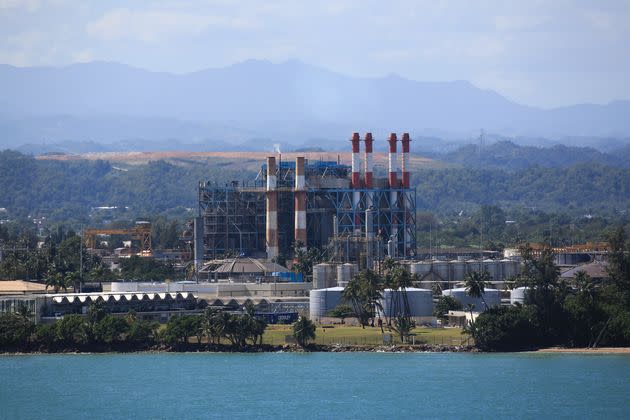
San Juan de Puerto Rico Power Station from the nearby San Felipe del Morro Castle in the old city of San Juan, Puerto Rico, United States. JordiStock via Getty Images
Despite the blowback to the LUMA deal and its own contract breach with PREPA, New Fortress still managed in January 2023 to win the contract to run Puerto Rico’s power plants.
Since then, New Fortress’ footprint in Puerto Rico has continued to expand.
On an August afternoon, dredging boats sat moored in the bay, part of a federally funded project to deepen the waterway enough to allow larger LNG barges to pass. The dredging process, which some Puerto Rican officials claimed was primarily to accommodate larger cruise ships for tourism, got an influential early backer in Rep. Jenniffer González-Colón, the territory’s non-voting delegate to Congress and the front-runner for the governor’s mansion in next month’s election. In May, the U.S. Court of Appeals for the D.C. Circuit unanimously ruled that the U.S. Army Corps of Engineers and the National Marine Fisheries Service followed environmental laws when approving the dredging project.
In September, however, the Coast Guard issued a formal recommendation that the U.S. Department of Justice levy fines against New Fortress for bringing in ships that are too large for the bay itself.
By allowing for increased volumes to flow through the New Fortress gas terminal before an emergency plan is place, Avilés said, González-Colón was “the godmother of a potential natural disaster.”
A spokesperson for González-Colón did not respond to a request for comment.
New Fortress built two new gas-fired power stations. This past March, the company sold the plants to PREPA, which has received billions of dollars from the Federal Emergency Management Administration, for nearly $400 million. That same month, the company received another deal to supply more gas to Puerto Rico. Selling PREPA the power stations, New Fortress said in an investor presentation, “ensures installed power remains part of Puerto Rico’s infrastructure” and “more than doubles” the company’s “gas supply opportunity on the island.”
In its financial reports, New Fortress has repeatedly cited the risk that its import terminal in San Juan would not be able to meet FERC’s requirements, which could result in federal regulators shutting down the facility.
But the company has sought to limit how much information it shares with the public in the documents it submits to FERC directly.
The draft emergency plan that New Fortress submitted to FERC is “so heavily redacted, with so much information blacked out,” that the nearly 200-page filing seems designed to confuse the public, said Ruth Santiago, an environmental lawyer involved in challenging the process.
“They’ve been saying for two years that they’re going to provide more information, but they’re filing this document with so much unresponsive paper that it’s just hard to keep track of,” she said. “And still it’s not anything final, and nobody seems to be taking responsibility for what could happen.”
Of the roughly three dozen times New Fortress asked FERC to keep information in its filings secret, the agency has yet to reject any request.
That’s not surprising, said Alison Gocke, an associate professor at the University of Virginia School of Law who specializes in energy regulations.
“From what I’ve seen in FERC’s pipeline approval process more generally, the agency tends to be fairly deferential to pipeline applicants’ requests, including requests for licenses to construct and operate pipelines,” she said in an email. Granting New Fortress’ requests for secrecy, she said, “is consistent with what I saw in the pipeline application process, where, at least over the last two decades, FERC rarely denied pipeline applicants’ requests for licenses to construct and operate pipelines.”
A FERC spokesperson declined HuffPost’s request for an interview, saying that “as a quasi-judicial regulatory agency, we are forbidden from public discussion of matters that are under review.”
Old Colonial Tensions
To Avilés, however, the lack of transparency and the power dynamics behind the New Fortress deal trace back more than a century.
The Dominican order of nuns to which Avilés belongs has a history in Puerto Rico dating back to the years after the U.S. seized the island as a colony following its victory in the Spanish-American War of 1898. As the U.S. military government started importing teachers to instruct Puerto Ricans on how to speak English, Catholic officials feared the new language would bring with it Protestant proselytizing. The Vatican sent a handful of bilingual nuns from Long Island, New York, down to Puerto Rico to help teach English and preserve the Catholic faith.
The nuns saw themselves as guardians of the local population and culture, going so far as to shelter anti-colonial protesters hiding from U.S. authorities after agitating for Puerto Rican independence became illegal.
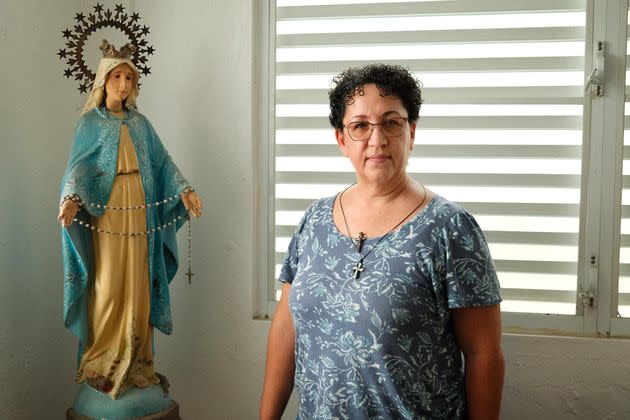
Sister Lissette Avilés Ríos, a nun from the San Juan area, stands in her home near the waterfront she fears is at risk from a natural gas import facility. Alexander Kaufman/HuffPost
“It was very hard for sisters to understand how a country can deny another country liberty when the postulates of the other country are founded on liberty itself,” Avilés said. “When the sisters came to Puerto Rico, it was a boiling pot those first few years because nationalists and independentistas who wanted Puerto Rico to be free were still strong and active.”
The conclusion her predecessors reached about the conditions in Puerto Rico is one she said remains true today: “They were immediately aware that, as a colony, we’d have problems from third-rate citizenship.”
Before joining the Catholic Church, Avilés was a marine biology student conducting field work for the federal Sea Grant program. The nun who recruited her told her she saw no conflict between scientific research and spreading the gospel, offering the promise to advocate for the safety of both the people and the creatures of her native island.
As we sat on folding chairs overlooking the bay, gnats swarmed us and a Caribbean species of black grackle hopped from rock to rock, eying us curiously. Asked if she had a favorite animal, Avilés answered without missing a beat: sea turtles.
“I identify with sea turtles because they come out of their safe zone to give life in conditions that are usually unfavorable to them,” she said, referring to the way the aquatic reptiles drag themselves onto beaches to lay eggs before returning to the sea. “I can relate to that.”
Related…
Source link : http://www.bing.com/news/apiclick.aspx?ref=FexRss&aid=&tid=6713a987f5a44b859116aa9ce35a7e33&url=https%3A%2F%2Fmalaysia.news.yahoo.com%2Flng-facility-puerto-rico-could-120002232.html&c=2487630072929360998&mkt=en-us
Author :
Publish date : 2024-10-19 01:16:00
Copyright for syndicated content belongs to the linked Source.

